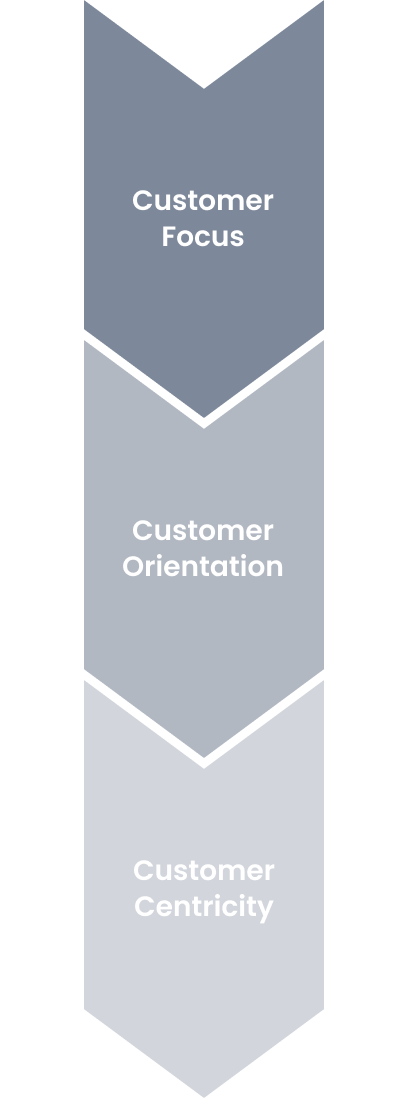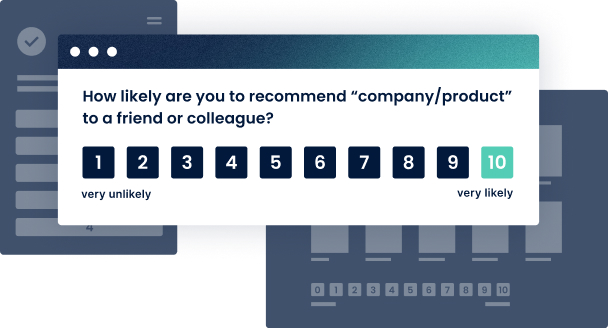Customer Focus
The New Core Strategy in Marketing
What measures can companies undertake to ensure success? The answer is clear—they need to change their focus away from the product and towards the customer! The customer must be put in the spotlight and at the center of everything they do, with their wishes and needs serving as a guide to the future. By taking this first step, you embark on a journey to success.
Table of Contents
- Customer Focus in Detail
- Changes in Marketing: Product Focus vs. Customer Focus
- Measures for Successful Customer Focus
- 4 Tips for More Customer Focus
- Digital Transformation: Customer Focus as a Leitmotif
- Marketing with Customer Focus: Concept and Application of the Net Promoter Score®
- Customer Focus — the First Step to Success
Customer Focus in Detail
Customers looking for a product or service are presented with a huge choice. Their decision for one over another may or may not be a conscious one. Numerous factors play a role here, above all, their needs and wishes. They no longer just want to be supplied with pure product information, but also actively believe in an authentic brand with values.
In order to adequately take this new purchasing behavior into account, customer focus is the first step in a long series of promising measures—and should not be left out under any circumstances. Those who choose to focus on the buyer also choose not to focus solely on the product. This can be very difficult for Marketing and Management—after all, it often means a drastic change of course.
Customer Focus: a definition
Companies that focus on buyers take into account customer wishes and expectations and attempt to serve them in the best possible way. To do this, it is imperative to know your customer’s preferences and want to address their problems. Only then can you offer customer-friendly service, solutions, and products. The first part of the customer focus strategy therefore, focuses primarily on stated and apparent customer expectations.
Customer Focus, Customer Orientation, and Customer Centering—What’s the Difference?
An important discovery for most companies is that focusing on customer needs and problems is the first and easiest step on the path to customer-centric business orientation. Customer wishes then accepted are usually those fitting neatly into the previous corporate goal. The company does not yet want to change its entire mission statement, but instead use the focus on the customer as a marketing strategy. This strategy is ideal for testing whether the focus on the customer generates positive feedback and promises greater success. If this is the case, further steps can be taken on the way to increasing customer focus.
Customer focus is thus only the beginning of a paradigm shift in corporate culture. This becomes clear after a detailed examination of the two concepts of customer orientation and customer centering, which we deal with in detail in further articles.
- Customer orientation: The term customer orientation is sometimes used as a synonym for focus on the customer, but orientation goes much further. Here, the meaning of ‘focusing on something’ is rather confusing. This is because customer orientation is also focused on the customer. However, the customer is not only a focal point but also a guiding and decisive factor. These influence the methods used whilst further pushing the customer into the center of the stage and, in conjunction with other aspects, direct the decision-making process. In addition, customer focus is a rather static, almost passive strategy: You look closely at customer wishes, but conclusions drawn from these do not make circles as wide as with actively designed customer orientation. Therefore, one should see and use these terms as separately as possible, especially in marketing.
- Customer centering: Customer centering goes one step further than customer orientation—here, the company aligns itself holistically with its clients and takes into account their unspoken needs. In addition, customer-centering influences the operation down to its mission statement, even if this necessitates adapting it.
So you can look at it as follows—focusing on the customer is the first step on the way to customer orientation. If this has been achieved, the company can ultimately focus on the goal of customer-centering. Alternately, first, you look at the customer and his known needs, then you use them as a guide for the further development of the business model, and at the end, the whole company and its mission statement completely align with the buyer. But where does this change of heart from pure product advertising to focusing on the customer come from?

Changes in Marketing: Product Focus vs. Customer Focus
Following the large wave of consumption in the early 1970s and 80s, company focus shifted away from products and towards the customer. Some companies are still clinging to the pure product focus, but it is becoming increasingly clear that one can no longer ignore man as an emotional being.
Thanks to the digital age, there are new questions about customer satisfaction. Modern marketing must keep pace and invest lots of commitment in learning and testing new opportunities. Ultimately, the focus on the buyer can become a starting point for decisions and, in some cases, even overwhelm the entire business plan. In order to ensure customer satisfaction, it is important to understand exactly where the differences between product and customer focus lie:
| Product focus | Customer focus |
| Customers pay more for better quality | Satisfied customers buy products |
| The aim is therefore to offer high-quality products and services | The goal is therefore to build long-term customer relationships |
| Quality and innovation are the focus | Keeping customers is easier than acquiring new ones |
| Pride in products creates employee ties | The buyer’s needs are in focus |
| High customer loyalty is the result |
Measures for Successful Customer Focus
If one orients oneself with studies, the market, and sales figures, one thing is clear: Companies that can count on loyal customers lead the market in many industries. So the rethink seems to be paying off. In order to be able to swim on this wave of success, it is necessary to understand and establish the focus on the interested parties as a new strategy in marketing.
But there is not just one road to success. This must be discovered and individually lived in each company. Nevertheless, there are general basic rules that help get to grips with this strategy. First of all, we should make the operational status quo clear and then determine the orientation. The following questions can be effective:
- For whom do we create value?
- Who are our most important customers?
- What are the specific problems they have?
- How do we solve these specific problems?
- What kind of relationship do customers expect from us?
- What measures must be taken to meet these expectations?
If this starts to give you difficulties, it can help to create concrete personas. A persona is a fictitious, representative person representing respective buyers. They are assigned certain characteristics that your clients have and then used to help you better answer the questions above. When the results are available, a new concept can be developed to plan your re-orientation. Marketing and Management departments should involve each other and share responsibility as they have the know-how to successfully address this new orientation.
Related:
Guide to factors that influence customer expectations of service
4 Tips for More Customer Focus
Good news for the company that employs its own Marketing team, because it is now on its shoulders to aid the development of the new core strategy. Depending on what is currently in use, new tools and opportunities may well be needed. The goal is to grab the interested party emotionally first and then convince them rationally. Sounds difficult? Luckily, marketing offers all sorts of tools that are great for this. This includes, for example, so-called neuro-marketing, which has since been scrutinized by various studies. Scientific findings are used to analyze buying habits and processes that subconsciously take place and to use the findings for further advertising. This includes the use of colors, choice of language, and symbolism. To understand this in concrete terms, the following four tips help:
1. Emotionalization
Move away from the monotonous preaching of the product details to the refreshing, emotional response of the people. This can only be achieved if one distances oneself from the argument and delivers to the emotional level. This must be expressed in all areas.
2. Watch your language!
You can actively use the sensations around letters to underline the message. For example, people perceive soft letters, such as M and L, and clear letters, such as A, as authentic. In addition, one should avoid long or difficult sentences and prefer to use familiar words. Here, simple and concrete sentences make your message clearer.
3. Storytelling
Storytelling is the telling of a story to make the advertising message clear. The principle is based on the scientific knowledge that stories told to people are better remembered than pure information. A well-structured story also creates authenticity, sympathy for the company, and, above all, an emotional bond. Storytelling is a great way to assign a story and specific emotions to each company. Therefore, it is absolutely necessary to orient oneself to the guiding principle and the company philosophy.
4. Symbolism
Certain symbols are linked to emotions in human thought. These can be used to unconsciously transport your own message. To do this, you have to be very familiar with this area and use the selected symbols in a balanced way. The message should not become too overloaded—otherwise, the individual symbols blend together and get lost in the noise.
When employees in Marketing take care to consistently implement emotionalization based on carefully created strategy and the points mentioned above, customer focus automatically becomes increasingly centered. When you get this far, you have to start involving other company departments and areas.
Digital Transformation: Customer Focus as a Leitmotif
Digital transformation is a hot topic on everyone’s lips and revolutionizes all areas of life—after all, it is the process of continuous development of all digital technologies. Digital transformation also plays a major role in everyday business, as customers use various technologies to search for products and make their purchasing decisions. Entrepreneurs must therefore either seize the opportunity of digitalization or fall by the wayside. In companies, the threads of digital transformation usually converge in the IT department. If one adds the customer focus as a leitmotif to the digital transformation, new possibilities grow. Here, too, it is important to know and implement the needs of the buyers. This starts in all online areas throughout the respective company, but the focus on the buyer must also be consistently continued offline.
To do this, the IT department must work hand in hand with Marketing and Management to adapt digital tools, such as AI, chatbots, or easy-to-use apps, to the new core strategy. Conversely, with the knowledge of the IT department, the Marketing department can make full use of the digital possibilities in the interests of its customers. Through an authentic digital implementation, you can achieve a high level of customer retention and attract loyal customers, but only if you continually keep an eye on this process. The question then arises, of course, how it is possible to check customer satisfaction at regular intervals.
Marketing with Customer Focus: Concept and Application of the Net Promoter Score®
Week for week, the Marketing department puts its entire commitment into the new core strategy. It takes time and nerves to integrate the individual departments and all employees, to work out new digital measures together with IT and to pass them on to customers. Now Management is expecting initial results and the Marketing staff is faced with the task of showing how and whether the customer focus is successful. At this point to find out how well focusing on the customer works in the company, you can work with different tools. Therefore remember the maxim—focus on the prospective customer is reflected in customer loyalty and this in turn in customer satisfaction. Therefore, it is a good way to measure customer satisfaction and customer loyalty.
One possible way to ask customers directly about their satisfaction is the Net Promoter Score®. Customers answer a question on a scale and can enter additional comments in a field. The NPS® can be calculated from the result. This can then be used to reflect customer satisfaction, how many loyal customers the company has, and also what can be improved. It is important that the comments in the text box are also evaluated because this is the only way to encounter problems and wishes and to see where the need for improvement lies. The holistic NPS system® can also be used for the evaluation of the free-text answers.
Also, feel free to check our NPS calculator here.

Customer Focus — the First Step to Success
The holistic Net Promoter Score proves the success of the new core strategy—customer focus has made a difference! Even if the first steps involved a lot of effort to move the old focus away from the product and towards the customer, it was worth the effort. Customer satisfaction and customer loyalty have been further increased by the new measures.
The Marketing department, together with IT and Management, is in charge of converting the new strategy with all its complex areas into a tailor-made concept for the whole company and then implementing it, for example, in service. Of course, there must be no tilting against windmills. Rather, the strategy must be done in comprehensible steps so that the company’s board and management can understand exactly what is at stake and what resources are needed for it. The more transparent the strategy is planned, the sooner the whole company will follow suit.
Even if the customer focus primarily addresses the expressed wishes of the customers, it is nevertheless important to involve the employees accordingly and to train them accordingly. This is the only way to make the company and the product be perceived as authentic, and only through such measures can companies and products develop further in the future with the support of loyal customers.
Maintaining customer focus with zenloop






